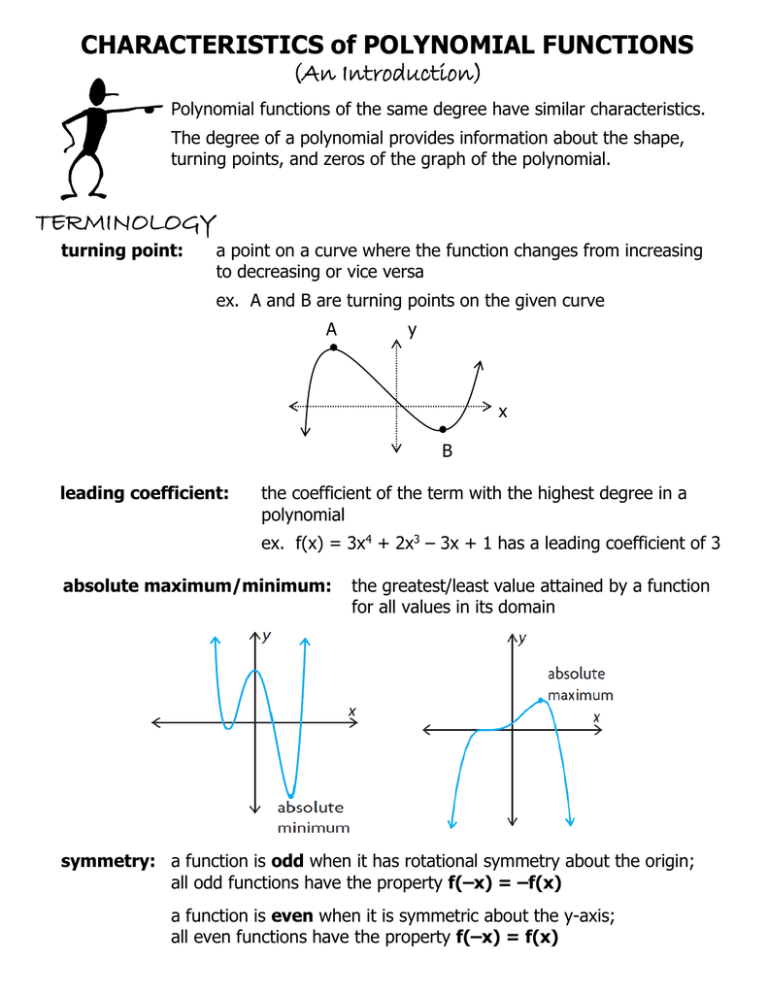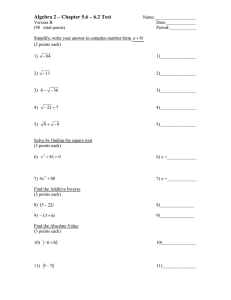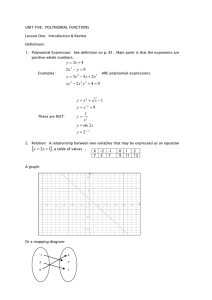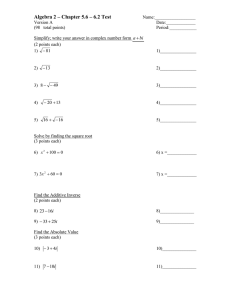CHARACTERISTICS of POLYNOMIAL FUNCTIONS (An Introduction)
advertisement

CHARACTERISTICS of POLYNOMIAL FUNCTIONS (An Introduction) Polynomial functions of the same degree have similar characteristics. The degree of a polynomial provides information about the shape, turning points, and zeros of the graph of the polynomial. TERMINOLOGY turning point: a point on a curve where the function changes from increasing to decreasing or vice versa ex. A and B are turning points on the given curve A y B leading coefficient: x the coefficient of the term with the highest degree in a polynomial ex. f(x) = 3x4 + 2x3 – 3x + 1 has a leading coefficient of 3 absolute maximum/minimum: the greatest/least value attained by a function for all values in its domain symmetry: a function is odd when it has rotational symmetry about the origin; all odd functions have the property f(–x) = –f(x) a function is even when it is symmetric about the y-axis; all even functions have the property f(–x) = f(x) Ex Recall the three cases for the solution(s) to a quadratic equation: NO SOLUTION ONE SOLUTION TWO SOLUTIONS (no zeros) (one zero) (two zeros) y y x y x x A quadratic equation has a degree of 2 and may have up to 2 zeros!! Ex Consider the polynomial function f(x) = 3x4 – 4x3 – 4x2 + 5x + 5: a) State the leading coefficient. ____________ b) State the degree of the polynomial. ____________ c) State the number of zeros. ____________ d) State the number of turning points. ____________ e) State the end behaviours (include the quadrant). ____________ f) ____________ Sketch. INVESTIGATION Complete the chart using a graphing calculator to aid in the sketches. NOTE: A few points about the graphing calculator: ● ● ● ● press window to set the scale for the x and y axes press y= to enter each equation and then press graph to view use ^ for entering exponents use (–) for a negative value CHARACTERISTICS of POLYNOMIAL FUNCTIONS (A Summary) Number of Zeros A polynomial function of degree n may have up to __________ distinct zeros. A polynomial of __________ degree must have at least one zero. A polynomial of __________ degree may have no zeros. Turning Points A polynomial function of degree n has at most __________ turning points. End Behaviours An odd degree polynomial function has opposite end behaviours. For a +ve leading coefficient, the function extends from Q ____ to Q ____. x , y ______ and x –, y ______ For a –ve leading coefficient, the function extends from Q ____ to Q ____. x , y ______ and x –, y ______ An even degree polynomial function has the same end behaviours. For a +ve leading coefficient, the function extends from Q ____ to Q ____. x ±, y ______ For a –ve leading coefficient, the function extends from Q ____ to Q ____. x ±, y ______ Ex State the degree, leading coefficient and end behaviours for each of the following polynomial functions: a) f(x) = 2x5 – 4x3 + 10x2 – 13x + 8 b) f(x) = –4x4 + 3x2 – 15x + 5 Ex Sketch a graph of a polynomial function that satisfies each set of conditions: a) degree 3 –ve leading coefficient 3 zeros 2 turning points b) degree 4 +ve leading coefficient 3 zeros 3 turning points y y x Homework: p.136–138 #1–8, 10–12 x








